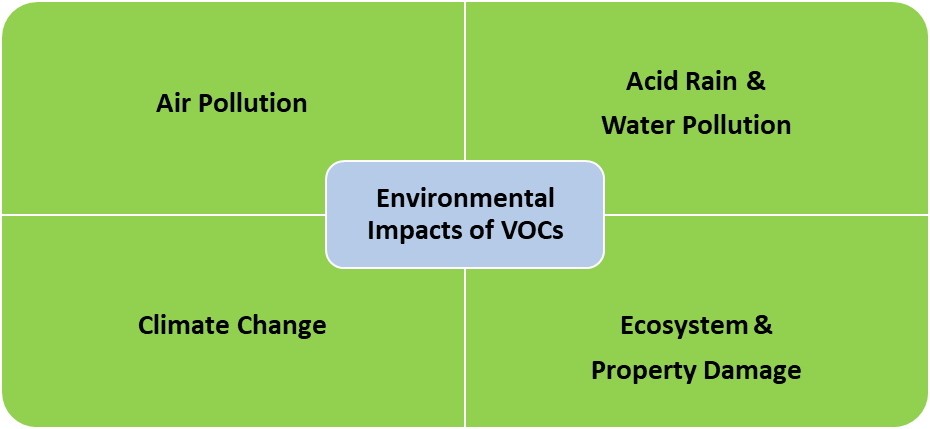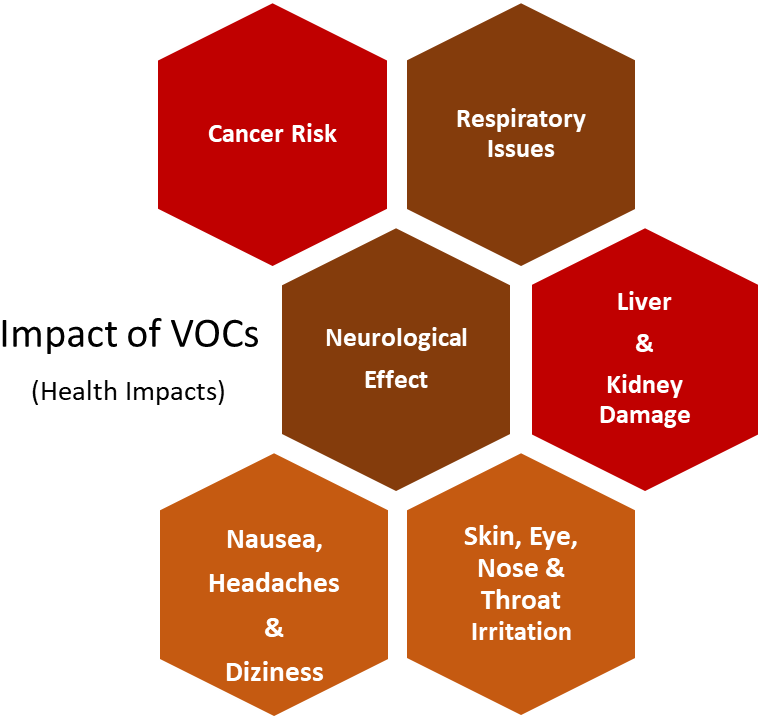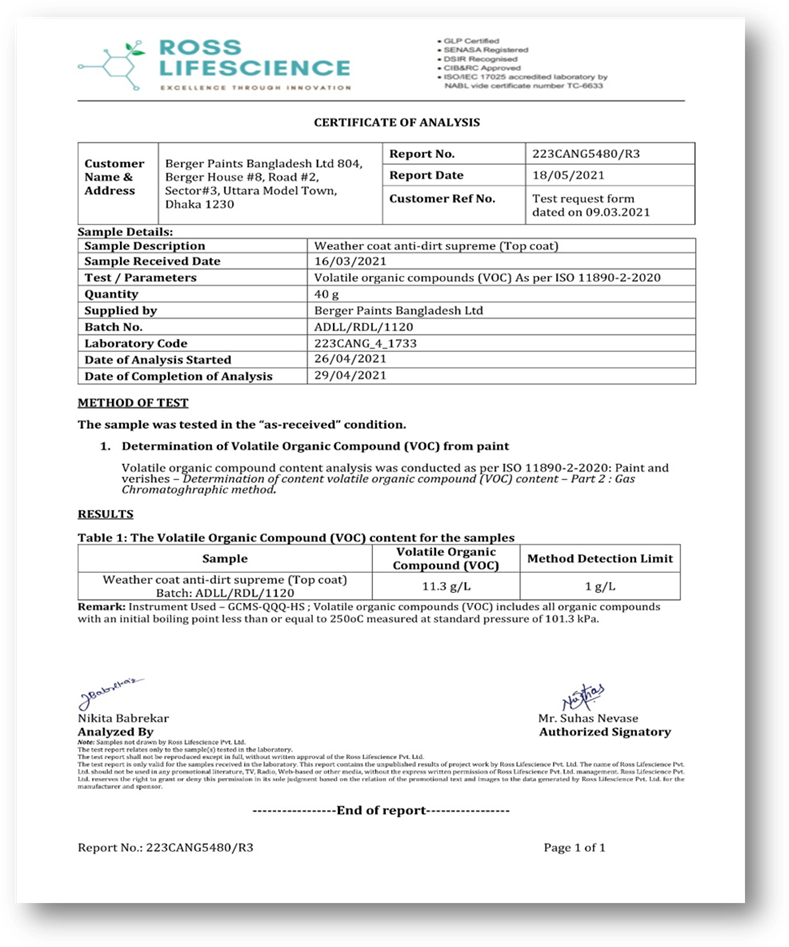In a general sense, common people consider pollution to be soil, water, noise and air pollution. Many of us are unaware of the nature and extent of pollution in a broad sense. Some pollutants work silently and can have long-term effects with prolonged exposure. One of them is VOCs pollution, which acts as a silent killer, and we are frequently affected by it. They have toxic effects not only on the human body but also on the environment. Volatile organic compounds are increasing the risk of global warming day by day.
What are the VOCs?
Volatile organic compounds are a type of chemical and organic compound that have a high vapour pressure at room temperature. High vapour pressure correlates with a low boiling point, which relates to the number of the sample’s molecules in the surrounding air, a trait known as ‘volatility’. Typically found in a gaseous form and is consequently widely produced by humans as well as distributed throughout the environment for a variety of domestic and commercial purposes.
Source of VOCs
VOCs mainly come from indoor and outdoor sources, most of which are man-made, with significant contributions from industrial and household products. Common examples of VOCs that may be present in our daily lives are benzene, ethylene glycol, formaldehyde, and methylene chloride. These compounds are primarily found in many paints, including both latex and oil-based paints, varnishes, cleaning products, personal care items, fuels, and even building materials like carpets and furniture. In the outdoor area, industrial emissions, vehicles and combustion are mainly responsible.

Health and Environmental Impact of VOCs
We are continuously exposed to VOCs both indoors and outdoors, posing health and environmental risks. Volatile organic compounds (VOCs) enter the air from paint, varnish, personal care, cleaning materials, tobacco smoke, fuel and thousands of other products and processes. They can increase the risk of airway problems and other health & environmental issues.

How VOCs Affect Human Health
Breathing in volatile organic compounds (VOCs) can harm your health.
They can cause short-term irritation or long-term health problems depending on how much and how long you’re exposed.
Short-Term Symptoms
Right after exposure, you might feel:
- Headaches, dizziness, or nausea
- Irritation in your eyes, nose, or throat
- Skin rashes or allergic reactions
These signs often appear in homes or offices with poor ventilation or strong chemical odors from paints, cleaning sprays, or air fresheners.
Long-Term Health Effects
Constant or repeated exposure can lead to more serious problems:
- Asthma or chronic bronchitis (NIH, 2023)
- Liver and kidney damage with long exposure (EPA, 2024)
- Memory loss and fatigue from nervous system stress
- Cancer risk, since benzene and formaldehyde are classified as Group 1 carcinogens by the IARC (2022)
Who Is Most at Risk?
Children, older adults, and pregnant women are the most sensitive.
Studies show that high VOC levels in nursery rooms or small apartments can raise the risk of asthma and developmental issues in kids (WHO, 2023).
Keeping homes well-ventilated and using low-VOC products can greatly reduce these risks.
How to reduce VOCs from paint
We use paints for beautification and protection at home, and when exposed to air, these VOCs spread throughout the house. Everyone living in the house is affected by this, especially children and the elderly. According to the Environmental Protection Agency (EPA), VOC levels are up to 10 times higher indoors than outdoors. Therefore, all raw materials responsible for VOCs in paint production should be avoided or kept to a tolerable limit. When purchasing a product, the quality must be ensured through the low VOCs label on the container or a certificate.
How VOCs Are Measured
VOCs are measured in grams per liter (g/L), especially for paints, coatings, and adhesives. The lower the number, the safer the product.
| VOC Level | Range (g/L) | Category |
| Severe High | > 250 | Very harmful |
| High | 100–249 | Unsafe for frequent indoor use |
| Medium | 50–99 | Moderate impact |
| Low | < 50 | Acceptable |
| Very Low | < 5 | Best for green-labeled products |
Many modern paints now advertise Low-VOC (<50 g/L) or Zero-VOC (<5 g/L) certifications. For example, Berger Paints (Bangladesh) and other multinational manufacturers have achieved VOC levels as low as 11 g/L in exterior products, aligning with EPA Method 24 and EU Directive 2004/42/EC standards.
Berger Paint (BD) Limited controls a large share of the paint market in Bangladesh, and all their water-based products are under the low VOCs category. For the past few decades, they have been working tirelessly with eco-friendly paints and go-green initiatives, which clearly demonstrates their commitment to the health of their customers and the environment. In addition, all other local and MNC companies will have to gradually bring their products to low VOC levels.

VOCs Test Report (Ross Life Science, India)
The above test report shows that the VOC content of Berger Weather Coat Anti-dirt Supreme was only 11.3 g/L (low VOC range: less than 50 g/L), which is in the low VOC paint category.
Bangladesh Paint Manufacturing Association (BPMA) and the Bangladesh Standards and Testing Institution (BSTI) should actively work on this issue. They have established a standard level of VOCs for each product and monitor whether companies are producing the products accordingly. At the same time, they should create widespread awareness among the customers on this issue. Similarly, urgent action must be taken regarding other materials responsible for VOC emissions, such as cleaning products, personal care items, pesticides, building and furniture materials, adhesives, and fuel combustion. Ultimately, we all need to work together to make this world pollution-free for ourselves and future generations; an eco-friendly solution is one way to achieve this.




